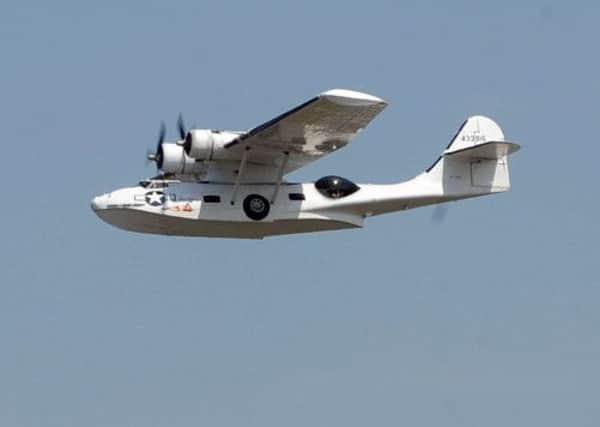Oldest seaplane takes to skies to mark 1913 flight


The only airworthy Catalina in the UK, now on display at the Imperial War Museum in Duxford, will be leaving its base on Wednesday to mark the 100th anniversary of the Circuit of Britain Race for Seaplanes staged in August, 1913.
The seaplane’s route will take the World War II flying boat from the North east of England on Thursday past the Montrose Air Station Heritage Centre to a flypast at Aberdeen airport and RAF Lossiemouth before the seaplane heads west to the Cromarty Firth and then down the Great Glen to Oban.
Advertisement
Hide AdAdvertisement
Hide AdThe crew will spend Friday in Oban before heading south and returning to Duxford on Saturday.
They are following the flight path of a Sopwith Waterplane flown by Australian aviation pioneers Harry Hawker and Harry Kauper whose plane was the only one of four aircraft entered for the contest to compete in the challenge.
One of the other pilots was killed in a flying accident only days before the Seaplane challenge was due to begin, and two other planes were withdrawn because of engine trouble.
The first attempt by the two Australians ended at Yarmouth with a cracked cylinder head and pilot exhaustion. They started again on 25 August but their seaplane crashed into the sea north of Dublin when Harry Hawker’s foot slipped off the rudder pedal while landing. The aircraft was destroyed and Harry Kauper broke his arm. but Harry Hawker escaped unscathed. Hawker had flown over 1000 miles of the 1540 mile race before crashing - the longest distance flown over water at the time.
The 2013 Circuit of Britain challenge - codenamed Project Hawker - is being mounted by Catalina pilot Jeff Boyling who, like Harry Hawker, was born in Australia.
He said: “Project Hawker 2013 is all about commemorating the 100th Anniversary of the attempt by the great Australian pilot Harry Hawker accompanied by his mechanic Harry Kauper, to fly a Circuit of Britain. “When they visited in 1913 there were tents on the southern shore at Cromarty for the Naval Air Station and this is where Harry Hawker brought the Sopwith Waterplane ashore. I’ve actually seen old film footage of him arriving so I am really looking forward to marking the 100th anniversary with a visit to the Cromarty Firth.”
Black Isle Councillor and local Historian, David Alston said: “Many people may not realise that Cromarty, and the Cromarty Firth, played an important role in aviation history. It is very appropriate, that 100 years after Harry Hawker flew his Sopwith into the firth, we will have this chance to see the flight repeated by an historical aircraft, which is the oldest airworthy seaplane in the UK.
“I hope as many people as possible take this unique opportunity to come and see the air display. There are lots of good vantage points both on the Black Isle and in Easter Ross and the stunning scenery will make the display even more poignant and memorable.”
Advertisement
Hide AdAdvertisement
Hide AdThe Catalina taking part in the anniversary flight was built in 1943 by Canadian Vickers at Cartierville, Quebec, and served with the Royal Canadian Air Force from 1943 until 1961. It then saw service as a firefighting seaplane in Canada and France before being based in 2004 at the Imperial War Museum.
The seaplane’s Scottish schedule.
Thursday 22 August
1030 Depart RAF Leeming
1048 Return to Whitby and then coastal route north
1105 Orbit Seaham. (Hawker put down here for repairs)
1128 Orbit Beadnell. (Hawker put down here too)
1202 EGQL RAF Leuchars
1216 Orbit Montrose Air Station Heritage Centre. Hawker put down here.
1225 Continue coastal to Stonehaven.
1231 Display at Aberdeen and flypast airport
1300 Peterhead
1310 Fraserburgh
1320 Banff (former Coastal Command base with monument)
1332 RAF Lossiemouth (Possible landing)
Continue west to Cromarty Firth.
1345 Orbit Invergordon
1347 Display at Cromarty
1400 Return to Invergordon and 1405 overfly Dingwall
1414 Overfly Dores to proceed down Great Glen
1424 Overfly Glendoe and 1436 Overfly Fort William
1450 Oban. Overfly Highland Games prior to closing and arrive Oban 1500
Friday 23 August
Rest Day in Oban with morning display over harbour at 1030. Aircraft open for inspection at Oban Airport in afternoon with short local flight late afternoon.
Saturday 24 August
1100 Depart Oban and overfly Oban Harbour then coastal route south to overfly North Coast and Kiells (Hawker set down for repairs here)
1156 Larne and then coastal route south
1226 Kilkeel and then enter Irish airspace
1241 Skerries
1242 Loughshinny
1245 Rush